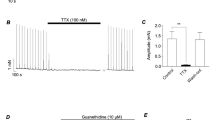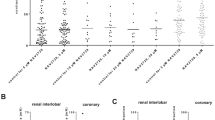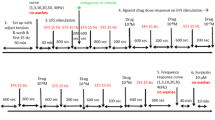Summary
The present paper examines the roles of postjunctional α1- and α2-adrenoceptors for the noradrenaline (NA)-induced neurogenic contractile response to field stimulation mainly with 1–100 pulses at 2 or 20 Hz, in the tail artery of adult normotensive rats. Pharmacological tools were employed to isolate and characterize the α1- and α2-adrenoceptor-mediated components of this response. The degree to which the drugs influenced NA release or reuptake was assessed by their effects on the electrochemically determined, stimulation-induced rise in the NA concentration at the innervated outer surface of the media. This response was unaffected by α,β-methylene ATP (10 μM) or suramin (500 μM), added to desensitize or block P2-purinoceptors, respectively prazosin (0.1 μM) or SK&F 104078 (6-chloro-9-[(3-methyl-2-butenyl)oxyl]-3-methyl-1H-2, 3, 4, 5-tetrohydro-3-benzazepine, 0.1 μM), used to block postjunctional α1- and α2-adrenoceptors respectively, nifedipine (10 μM), blocker of Ca2+ influx through L-type channels, and ryanodine (10 μM), which blocks mobilization of Ca2+ from intracellular stores; it was moderately enhanced by yohimbine (0.1 μM), blocker of pre- and postjunctional α2-adrenoceptors, and strongly enhanced by cocaine (3 μM) or desipramine (1 μM), blockers of NA reuptake. Judging from their inhibitory effects on the contractile responses to the α1- and α2-adrenoceptor agonists, phenylephrine andxylazine, prazosin (0.1 μM)and SK & F 104078 (0.1 μM) could be used to selectively block α1- and α2-adrenoceptors respectively, while yohimbine (0.1 μM) was less selective, strongly depressing α2- and slightly depressing α1-adrenoceptor-mediated responses. The α1-adrenoceptor-mediated component of the contractile response to short trains at 20 Hz was fast in onset, brief in duration and abolished by ryanodine; that mediated by α2-adrenoceptors was more delayed, prolonged and insensitive to ryanodine. Both components were dose-dependently depressed by nifedipine (0.1–10 μM). The small contractile responses to single pulses, or up to 50 pulses at 2 Hz, or short train (< 4 pulses) at 20 Hz, were more markedly depressed by 0.1 μM yohimbine or SK & F 104078 than by 0.1 μM prazosin and, hence, mediated mainly by α2-adrenoceptors. The reverse was true of the much larger response to longer trains at 20 Hz, which thus probably was mediated mainly by α1-adrenoceptors. Cocaine or desipramine, as well as α,β-methylene ATP or suramin, amplified both components of the NA induced contractile response especially that mediated via a1-adrenoceptors and caused by single pulses or short trains.
The main conclusions are (i) that the small NA-induced contractile responses of this artery to single pulses, or pulses at low frequency, or in short trains at high frequency, are mediated mainly via α2-, and the larger responses to longer trains at high frequency increasingly via α1-adrenoceptors, (ii) that the α1- and α2-adrenoceptor-mediated components interact cooperatively, probably at least in part by utilizing two different pathways to increase the intracellular Ca2+, (iii) that neuronal reuptake of NA strongly restricts both components of the NA-induced contraction, especially the α1-adrenoceptor-mediated response to single pulses or short trains, and (iv) that both components of the NA-induced contraction, especially that mediated by α1-adrenoceptors, may be depressed by ATP released by field stimulation and acting via P2x-purinoceptors on smooth muscle. Based on these results a novel working hypothesis is proposed, in which it is assumed that the geometry of NA-mediated neuromuscular transmission in this vessel varies with the frequency and number of impulses in a stimulus train.
Similar content being viewed by others
References
Abe K, Saito H, Matsuki N (1990) Changes in intracellular free Ca2+ concentration by activation of α-adrenoceptors in rat tail artery. Jpn J Pharmacol 52:337–344
Åstrand P, Stjarne L (1989) On the secretory activity of single varicosities in the sympathetic nerves innervating the rat tail artery. J Physiol (Lond) 409:207–220
Atkinson J, Trescases N, Benedek C, Boillat N, Fouda AK, Krause F, Pitton MC, Rafizadeh C, de Rivaz JC, Sautel M, Sonnay M (1988) Alpha-1 and alpha-2 adrenoceptor agonists induce vasoconstriction of the normotensive rat caudal artery in vitro by stimulation of a heterogenous population of alpha-1 adrenoceptors. Naunyn-Schmiedeberg's Arch Pharmacol 338:529–535
Bao JX, Stjärne L (1990) Relative importance of postjunctional α1-and α2-adrenoceptors and P2x- purinoceptors for the neurogenic contraction in rat tail artery varies with the stimulus parameters. Blood Vessels 27:29
Bao JX, Eriksson IE, Stjärne L (1989a) On pre- and/or post-junctional roles of ATP and an unknown ‘substance X’ as sympathetic co-transmitters in rat tail artery. Acta Physiol Scand 135:65–66
Bao JX, Eriksson IE, Stjärne L (1989b) Neurogenic contractions in tail artery of nomotensive rats are mediated by noradrenaline and ATP via postjunctional α1- and α2-adrenoceptors and P2x-purinoceptors. Acta Physiol Scand 136:139–140
Bao JX, Eriksson IE, Stjärne L (1989c) Age-related variations in the relative importance of noradrenaline and ATP as mediators of the contractile response of rat tail artery to sympathetic nerve stimulation. Acta Physiol Scand 136:287–288
Bao JA, Eriksson IE, Stjärne L (1989d) Neurogenic contractions in caudal artery from young rats: receptor-receptor interaction and regional differences in effects of noradrenaline and ATP via α1-, α2-and P2x-receptors. Acta Physiol Scand 136:619–620
Bao JX, Eriksson IE, Stjärne L (1990) Neurotransmitters and pre- and postjunctional receptors involved in the vasoconstrictor response to sympathetic nerve stimulation in rat tail artery. Acta Physiol Scand 140:467–479
Bao JX, Gonon F, Stjärne L (1991) Electrochemical and electrophysiological analysis of the effects of SK&F 104078 on prejunctional α2-adrenoceptors. Eur J Pharmacol 203:159–163
Bowman WC, Rand MJ (1980) Quantitative evaluation and statistical analysis of drug action. In: Bowman WC, Rand MJ (eds) Textbook of pharmacology, 2nd edn. Blackwell, Oxford, pp 41.1–41.48
Bulloch JM, Docherty JR, Flavahan NA, McGrath JC, McKean CE (1987) Difference in the potency of α2-adrenoceptor agonists and antagonists between the pithed rabbit and rat. Br J Pharmacol 91:457–466
Bültmann R, von Kügelgen I, Starke K (1991) Contraction-mediating α2-adrenoceptors in the mouse vas deferens. Naunyn-Schmiedeberg's Arch Pharmacol 343:623–632
Cassell JF, McLachlan EM, Sittiracha T (1988) The effect of temperature on neuromuscular transmission in the main caudal artery of the rat. J Physiol (Lond) 397:31–49
Cheung DW (1984) Neural regulation of electrical and mechanical activities in the rat tail artery. Pflügers Arch 400:335–337
Daly CJ, McGrath JC, Wilson VG (1988) Pharmacological analysis of postjunctional α-adrenoceptors mediating contractions to (−)-noradrenaline in the rabbit isolated lateral saphenous vein can be explained by interacting responses to simultaneous activation of α1- and α2-adrenoceptors. Br J Pharmacol 95:485–500
Dashwood M, Jacobs M (1985) Autoradiographic study of the alpha-adrenoceptors of rat aorta and tail artery. Eur J Pharmacol 115:129–130
Docherty JR (1989) The pharmacology of α1- and α2-adrenoceptors: evidence for and against a further subdivision. Pharmacol Ther 44:241–284
Docherty JR, Hyland L (1985) Evidence for neuro-effector transmission through postjunctional α2-adrenoceptors in human saphenous vein. Br J Pharmacol 84:573–576
Dunn PM, Blakeley AGH (1988) Suramin: a reversible P2-purinoceptor antagonist in the mouse vas deferens. Br J Pharmacol 93:243–245
Dunn WR, Daly CJ, McGrath JC, Wilson VG (1991a) The effects of nifedipine on α2-adrenoceptor-mediated contraction in several isolated blood vessels from the rabbit. Br J Pharmacol 103:1493–1499
Dunn WR, McGrath JC, Wilson VG (1991b) Postjunctional α-adrenoceptors in the rabbit isolated distal saphenous artery: indirect sensitivity to prazosin of responses to noradrenaline mediated via postjunctional α2-adrenoceptors. Br J Pharmacol 103:1484–1492
Elsner D, Saeed M, Sommer O, Holtz J, Bassenge E (1984) Sympathetic vasoconstriction sensitive to α2-adrenergic receptor blockade. No evidence for preferential innervation of α1-adrenergic receptors in the canine femoral bed. Hypertension 6:915–925
Flavahan NA, Rimele TJ, Cooke JP, Vanhoutte PM (1984) Characterization of postjunctional alpha-1 and alpha-2 adrenoceptors activated by exogenous or nerve-released norepinephrine in the canine saphenous vein. J Pharmacol Exp Ther 230:699–705
Gardiner JC, Peters CJ (1982) Postsynaptic α1- and α2-adrenoceptor involvement in the vascular responses to neurally released and exogenous noradrenaline in the hindlimb of the dog and cat. Eur J Pharmacol 84:189–198
Hirning LD, Fox AP, McCleskey EW, Olivera BM, Thayer SA, Miller RJ, Tsien RW (1988) Dominant role of N-type Ca2+ channels in evoked release of norepinephrine from sympathetic neurons. Science 239:57–61
Hirst GDS, Edwards FR (1989) Sympathetic neuroeffector transmission in arteries and arterioles. Physiol Rev 69:546–604
Ito K, Takakura S, Sato K, Sutko JL (1986) Ryanodine inhibits the release of calcium from intracellular stores in guinea-pig aortic smooth muscle. Circ Res 58:730–734
Itoh T, Kitamura K, Kuriyama H (1983) Roles of extrajunctional receptors in the response of guinea-pig mesenteric and rat tail arteries to adrenergic nerves. J Physiol (Lond) 345:409–422
Kasakov L, Burnstock G (1983) The use of the slowly degradable analog, α,β-methylene ATP, to produce desensitization of the P2-purinoceptor: Effect on non-adrenergic, non-cholinergic responses of the guinea-pig urinary bladder. Eur J Pharmacol 86:291–2294
Langer SZ, Hicks PE (1984) Alpha-adrenoceptor subtype in blood vessels: physiology and pharmacology. J Cardiovasc Pharmacol 6:S547-S558
Langer SZ, Massingham R, Shepperson NB (1980) Presence of postsynaptic α2-adrenoceptors of predominantly extrasynaptic location in the vascular smooth muscle of the dog hind limb. Clin Sci 59 [Suppl 6]:225s–228s
Langer SZ, Massingham R, Shepperson NB (1981) Preferential longlasting blockade of neuronally released but not exogenously administered noradrenaline in vitro: Further evidence that α1-adrenoceptor subtype predominates intrasynaptically. Br J Pharmacol 73:281P–282P
Lavidis NA, Bennett MR (1992) Probabilistic secretion of quanta from visualized sympathetic nerve varicosities in mouse vas deferens. J Physiol (Lond) 454:9–26
Luff SE, McLachlan EM (1989) Frequency of neuromuscular junctions on arteries of different dimensions in the rabbit, guinea-pig and rat. Blood Vessels 26:95–106
MacLean MR, McGrath JC (1990) Effects of pre-contraction with endothelin-1 on α2-adrenoceptor- and (endothelium-dependent) neuropeptide Y-mediated contractions in the isolated vascular bed of the rat tail. Br J Pharmacol 101:205–211
Marwood JF, Chapman KL, Armsworth SJ, Stokes GS (1985) Investigation into the nature of α2-adrenoceptors in rat tail arteries. Clin Exp Pharmacol Physiol 12:231–234
Marwood JF, Chapman KL, Stokes GS (1986) Studies that question the existence of alpha-2 adrenoceptors in tail arteries of normotensive Sprague-Dawley rats. J Pharmacol Exp Ther 238:267–272
McGrath JC (1982) Evidence for more than one type of postjunctional α-adrenoceptors. Biochem Pharmacol 31:467–484
McGrath JC, Flavahan NA, McKean CE (1982) α1- and α2-adrenoceptor-mediated pressor and chronotropic effects in the rat and rabbit. J Cardiovasc Pharmacol 4:S101-S107
McGrath JC, Wilson VG, Dunn WR, Templeton AGB (1991) The interaction between α1- and α2-adrenoceptors — The search for vascular α2-adrenoceptors in vitro. In: Adrenoceptors: Structure, Mechanisms, Function. Advances in Pharmacological Sciences. Birkhäuser Verlag, Basel, pp 211–220
Medgett IC (1985) α2-Adrenoceptors mediate sympathetic vasoconstriction in distal segments of rat tail artery. Eur J Pharmacol 108:281–287
Medgett IC, Langer SZ (1984) Heterogeneity of smooth muscle alpha adrenoceptors in rat tail artery in vitro. J Pharmacol Exp Ther 229:823–830
Mermet C, Gonon FG, Stjärne L (1990) Online electrochemical monitoring of the local noradrenaline release evoked by electrical stimulation of the sympathetic nerves in isolated rat tail artery. Acta Physiol Scand 140:323–329
Msghina M, Mermet C, Gonon F, Stjärne L (1992) Electrophysiological and electrochemical analysis of the secretion of ATP and noradrenaline from the sympathetic nerves in rat tail artery: effects of α2-adrenoceptor agonists and antagonists and noradrenaline reuptake blockers. Naunyn-Schmiedeberg's Arch Pharmacol 346: 173–186
Muir TC, Wardle KA (1989) Vascular smooth muscle responses in normo- and hypertensive rats to sympathetic nerve stimulation and putative transmitters. J Anton Pharmacol 9:23–34
Ohyanagi M, Faber JE, Nishigaki K (1991) Differential activation of α1- and α2-adrenoceptors on microvascular smooth muscle during sympathetic nerve stimulation. Circ Res 68:232–244
Papanicolaou M, Medgett IC (1986) Effects of blockade of α1- and α2-adrenoceptors on vasoconstrictor response to single and twin pulse stimulation in rat tail artery. Eur J Pharmacol 131:211–218
Rajanayagam MAS, Medgett IC (1987) Greater activation of smooth muscle alpha-2 adrenoceptors by epinephrine in distal than in proximal segments of rat tail artery. J Pharmacol Exp Ther 240:989–997
Ruffolo RR Jr, Sulpizio AC, Nichols AJ, Demarinis RM, Hieble JP (1987) Pharmacological differentiation between pre- and postjunctional α2-adrenoceptors by SK&F 104078. Naunyn-Schmiedeberg's Arch Pharmacol 336:415–418
Ruffolo RR Jr, Nichols AJ, Stadel JM, Hieble JP (1991) Structure and function of α-adrenoceptors. Pharmacol Rev 43:475–505
Sneddon P, Burnstock G (1984) ATP as a co-transmitter in rat tail artery. Eur J Pharmacol 106:149–152
Stevens MJ, Moulds RFW (1985) Neuronally released norepinephrine does not preferentially activate postjunctional α1-adrenoceptors in human blood vessels in vitro. Circ Res 57:399–405
Stjärne L (1989) Basic mechanisms and local modulation of nerve impulse-induced secretion of neurotransmitters from individual sympathetic nerve varicosities. Rev Physiol Biochem Pharmacol 112:1–137
Stjärne L, Bao JX, Gonon F, Msghina M, Stjärne E (1992) On the geometry, kinetics and plasticity of sympathetic neuromuscular transmission. Jpn J Pharmacol 58 [Suppl II]:158p-165p
Su CM, Swamy VC, Triggle DJ (1986) Postsynaptic α-adrenoceptor characterization and Ca2+ channel antagonist and activator actions in rat tail artery from normotensive and hypertensive animals. Can J Physiol Pharmacol 64:909–921
Sulpizio A, Hieble JP (1991) Lack of pharmacological distinction between alpha-1 adrenoceptors mediating intracellular calcium-dependent and independent contractions to sympathetic nerve stimulation in the perfused rat caudal artery. J Pharmacol Exp Ther 257:1045 -1052
Templeton AGB, Macmillan J, McGrath JC, Storey ND, Wilson VG (1989) Evidence for prazosin-resistant, rauwolscine-sensitive α-adrenoceptors mediating contraction in the isolated vascular bed of the rat tail. Br J Pharmacol 97:563–571
van Zwieten PA, Timmermans PBMWM (1987) α-Adrenoceptor stimulation and calcium movements. Blood Vessels 24:271–280
Vidal M, Hicks PE, Langer SZ (1986) Differential effects of α-β-methylene ATP on responses to nerve stimulation in SHR and WKY tail arteries. Naunyn-Schmiedeberg's Arch Pharmacol 332:384–390
von Kügelgen I, Bültmann R, Starke K (1989) Effects of suramin and α,β-methylene ATP indicate noradrenaline-ATP co-transmission in the response of the mouse vas deferens to single and low frequency pulses. Naunyn-Schmiedeberg's Arch Pharmacol 340:760–763
Webb RC, Vanhoutte PM, Bohr DF (1980) Inactivation of released norepinephrine in rat tail artery by neuronal uptake. J Cardiovasc Pharmacol 2:121–132
Weiss RJ, Webb RC, Smith CB (1983) α2-Adrenoceptors on arterial smooth muscles: selective labelling by [3H] clonidine. J Pharmacol Exp Ther 225:599–605
Westfall DP, Sedaa K, Bjur RA (1987) Release of endogenous ATP from rat caudal artery. Blood Vessels 24:125–127
Wilffert B, Timmermans PBMWM, van Zwieten PA (1982) Extrasynaptic location of alpha-2 and noninnervated beta-2 adrenoceptors in the vascular system of the pithed normotensive rat. J Pharmacol Exp Ther 221:762–768
Xiao X-H, Rand MJ (1989) α2-Adrenoceptor agonists enhance vasoconstrictor response to α1-adrenoceptor agonists in the rat tail artery by increasing the influx of Ca2+. Eur J Pharmacol 98:1032–1038
Yamaguchi I, Kopin IJ (1980) Differential inhibition of alpha-1 and alpha-2 adrenoceptor mediated pressor responses in pithed rats. J Pharmacol Exp Ther 214:275–281
Author information
Authors and Affiliations
Additional information
Correspondence to J.-X. Bao at the above address
Rights and permissions
About this article
Cite this article
Bao, JX., Gonon, F. & Stjärne, L. Frequency- and train length-dependent variation in the roles of postjunctional α1- and α2-adrenoceptors for the field stimulation-induced neurogenic contraction of rat tail artery. Naunyn-Schmiedeberg's Arch Pharmacol 347, 601–616 (1993). https://doi.org/10.1007/BF00166943
Received:
Accepted:
Issue Date:
DOI: https://doi.org/10.1007/BF00166943




